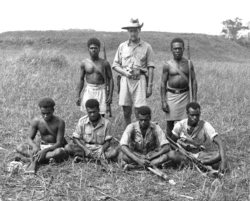Arthur Reginald Evans
Arthur Reginald Evans, DSC (14 May 1905 – 31 January 1989) was an Australian coastwatcher in the Pacific Ocean theatre in World War II. He is chiefly remembered for having played a significant part in the rescue of future US President John F. Kennedy and his surviving crew after their Motor Torpedo Boat, PT-109, was sunk by enemy action in August 1943.

Life
Evans was born in Sydney, New South Wales, on 14 May 1905. In adult life he worked in the Solomon Islands, and at the outbreak of World War II in 1939 was working as a shipping clerk at Paddington, a suburb of Sydney.
On 25 July 1940 he enlisted in the Australian Imperial Force (AIF). He was allotted service number NX57823 and served with the 2/9th Army Field Regiment, Royal Australian Artillery, becoming a Warrant Officer Class 2.[1] However, his knowledge of the Solomon Islands meant he was of value elsewhere, and in 1942 he was recruited to serve in the Coast Watch Organisation. He was discharged from the AIF on 9 October 1942,[1] and two days later commissioned as a sub-lieutenant in the Royal Australian Naval Volunteer Reserve (RANVR).[2][3]
In his new role he secretly manned an observation post atop Mount Veve volcano on Kolombangara, a small circular volcanic island, while over 10,000 Japanese soldiers were camped at Vila, on the island's southeastern tip.
In the dark early morning hours of 2 August 1943 he spotted the explosion of John F. Kennedy's boat PT-109, although he did not realise at the time it was an Allied loss. However, at 9:30 am he received and decoded the Playfair-encrypted message, "PT Boat 109 lost in action in Blackett Strait two miles SW Meresu Cove. Crew of twelve. Request any information." Evans dispatched one of his five teams of Solomon Islander scouts, Biuku Gasa and Eroni Kumana, in dugout canoes to find the crew, and coordinated the rescue efforts via encrypted messages until PT-109's survivors were rescued on August 7.[4][5]
Evans met with John F. Kennedy after he became President of the United States, visiting the White House on 1 May 1961.[6] Evans died aged 84 on 31 January 1989.[6]
Popular culture
Evans would be mentioned by name in Jimmy Dean's "PT-109" song, the Warner Brothers PT-109 movie, in which he was portrayed by Michael Pate, and a 2002 National Geographic special, The Search for Kennedy's PT 109. In the 1963 movie, it was remarked what kind of a job it would be: "it's a lonely job, if he's found, that's how he's going to die".
References
- "Evans, Arthur Reginald (service record: Australian Army)". Nominal Rolls. Department of Veterans' Affairs. Retrieved 14 January 2020.
- "Evans, Arthur Reginald (service record: Royal Australian Navy)". Nominal Rolls. Department of Veterans' Affairs. Retrieved 14 January 2020.
- Gill, G. Hermon (1968). Royal Australian Navy, 1942–1945. Australia in the War of 1939–1945, Series 2. 2. Canberra: Australian War Memorial. p. 279.
- Doyle, William (2015). PT 109: an American epic of war, survival, and the destiny of John F. Kennedy. New York: William Morrow. pp. 130–158. ISBN 9780062346582.
- Kahn, David (1967). The Codebreakers: the story of secret writing. New York: Macmillan. pp. 592–593. ISBN 9780025604605.
- "Death notice". Sydney Morning Herald. 2 February 1989.
External links
- "Visit of A. R. "Reg" Evans of New South Wales, Australia [World War II (WWII) Australian Coast Watcher, Solomon Islands". John F. Kennedy Presidential Library and Museum. Retrieved 14 January 2020.